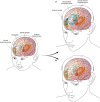Behavioral inhibition and developmental risk: a dual-processing perspective
- PMID: 25065499
- PMCID: PMC4262899
- DOI: 10.1038/npp.2014.189
Behavioral inhibition and developmental risk: a dual-processing perspective
Abstract
Behavioral inhibition (BI) is an early-appearing temperament characterized by strong reactions to novelty. BI shows a good deal of stability over childhood and significantly increases the risk for later diagnosis of social anxiety disorder (SAD). Despite these general patterns, many children with high BI do not go on to develop clinical, or even subclinical, anxiety problems. Therefore, understanding the cognitive and neural bases of individual differences in developmental risk and resilience is of great importance. The present review is focused on the relation of BI to two types of information processing: automatic (novelty detection, attention biases to threat, and incentive processing) and controlled (attention shifting and inhibitory control). We propose three hypothetical models (Top-Down Model of Control; Risk Potentiation Model of Control; and Overgeneralized Control Model) linking these processes to variability in developmental outcomes for BI children. We argue that early BI is associated with an early bias to quickly and preferentially process information associated with motivationally salient cues. When this bias is strong and stable across development, the risk for SAD is increased. Later in development, children with a history of BI tend to display normative levels of performance on controlled attention tasks, but they demonstrate exaggerated neural responses in order to do so, which may further potentiate risk for anxiety-related problems. We conclude by discussing the reviewed studies with reference to the hypothetical models and make suggestions regarding future research and implications for treatment.
Figures


Similar articles
-
Consequences of Not Planning Ahead: Reduced Proactive Control Moderates Longitudinal Relations Between Behavioral Inhibition and Anxiety.J Am Acad Child Adolesc Psychiatry. 2019 Aug;58(8):768-775.e1. doi: 10.1016/j.jaac.2018.06.040. Epub 2019 Jan 9. J Am Acad Child Adolesc Psychiatry. 2019. PMID: 30768398 Free PMC article.
-
Understanding the Emergence of Social Anxiety in Children With Behavioral Inhibition.Biol Psychiatry. 2021 Apr 1;89(7):681-689. doi: 10.1016/j.biopsych.2020.10.004. Epub 2020 Oct 10. Biol Psychiatry. 2021. PMID: 33353668 Free PMC article. Review.
-
Stable early maternal report of behavioral inhibition predicts lifetime social anxiety disorder in adolescence.J Am Acad Child Adolesc Psychiatry. 2009 Sep;48(9):928-935. doi: 10.1097/CHI.0b013e3181ae09df. J Am Acad Child Adolesc Psychiatry. 2009. PMID: 19625982 Free PMC article.
-
Development of inhibitory control during childhood and its relations to early temperament and later social anxiety: unique insights provided by latent growth modeling and signal detection theory.J Child Psychol Psychiatry. 2019 Jun;60(6):622-629. doi: 10.1111/jcpp.13025. Epub 2019 Feb 18. J Child Psychol Psychiatry. 2019. PMID: 30775788 Free PMC article.
-
The etiology of social phobia: toward a developmental profile.Clin Psychol Rev. 2003 Nov;23(6):761-86. doi: 10.1016/s0272-7358(03)00076-x. Clin Psychol Rev. 2003. PMID: 14529697 Review.
Cited by
-
Validation of the Italian Version of the Behavioral Inhibition Questionnaire (BIQ) for Preschool Children.Int J Environ Res Public Health. 2021 May 21;18(11):5522. doi: 10.3390/ijerph18115522. Int J Environ Res Public Health. 2021. PMID: 34063941 Free PMC article.
-
The Overcontrol in Youth Checklist (OCYC): Behavioral and Neural Validation of a Parent-Report of Child Overcontrol in Early Childhood.Child Psychiatry Hum Dev. 2020 Feb;51(1):27-38. doi: 10.1007/s10578-019-00907-3. Child Psychiatry Hum Dev. 2020. PMID: 31256293 Free PMC article.
-
The neurobiology of emotion-cognition interactions: fundamental questions and strategies for future research.Front Hum Neurosci. 2015 Feb 17;9:58. doi: 10.3389/fnhum.2015.00058. eCollection 2015. Front Hum Neurosci. 2015. PMID: 25774129 Free PMC article. Review.
-
Cognitive flexibility-related prefrontal activation in preschoolers: A biological approach to temperamental effortful control.Dev Cogn Neurosci. 2019 Aug;38:100651. doi: 10.1016/j.dcn.2019.100651. Epub 2019 May 24. Dev Cogn Neurosci. 2019. PMID: 31154272 Free PMC article.
-
Understanding anxiety symptoms as aberrant defensive responding along the threat imminence continuum.Neurosci Biobehav Rev. 2023 Sep;152:105305. doi: 10.1016/j.neubiorev.2023.105305. Epub 2023 Jul 5. Neurosci Biobehav Rev. 2023. PMID: 37414377 Free PMC article. Review.
References
-
- Biederman J, Rosenbaum JF, Chaloff J, Kagan J (1995). Behavioral inhibition as a risk factor for anxiety disorders. In: March JS (ed.) Anxiety Disorders in Children and Adolescents. Guilford Press: New York, NY, pp 61–81.
Publication types
MeSH terms
Grants and funding
LinkOut - more resources
Full Text Sources
Other Literature Sources
Medical

